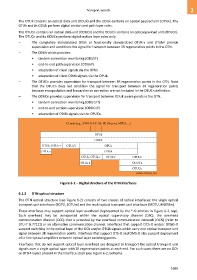Page 1105 - 5G Basics - Core Network Aspects
P. 1105
Transport aspects 2
The OTUk contains an optical data unit (ODUk) and the ODUk contains an optical payload unit (OPUk). The
OTUk and its ODUk perform digital section and path layer roles.
The OTUCn contains an optical data unit (ODUCn) and the ODUCn contains an optical payload unit (OPUCn).
The OTUCn and its ODUCn perform digital section layer roles only.
– The completely standardized OTUk or functionally standardized OTUk-v and OTUkV provide
supervision and conditions the signal for transport between 3R regeneration points in the OTN.
– The ODUk which provides:
• tandem connection monitoring (ODUkT)
• end-to-end path supervision (ODUkP)
• adaptation of client signals via the OPUk
• adaptation of client ODUk signals via the OPUk.
– The OTUCn provides supervision for transport between 3R regeneration points in the OTN. Note
that the OTUCn does not condition the signal for transport between 3R regeneration points
because encapsulation and forward error correction are not included in the OTUCn definition.
– The ODUCn provides supervision for transport between ODUk aware points in the OTN.
• tandem connection monitoring (ODUCnT)
• end-to-end section supervision (ODUCnP)
• adaptation of ODUk signals via the OPUCn.
Figure 6-1 Digital structure of the OTN interfaces
6.1.2 OTN optical structure
The OTN optical structure (see Figure 6-2) consists of two classes of optical interfaces: the single optical
transport unit interfaces (SOTU, SOTUm) and the multi optical transport unit interfaces (MOTU, MOTUm).
These interfaces may support optical layer overhead (represented by the *-O entities in Figure 6-2, top).
Such overhead may be transported within the optical supervisory channel (OSC), the overhead
communication channel (OCC) that is provided by the overhead communication network (OCN) (refer to
[ITU-T G.7712]) or an alternative communication channel. Interfaces that support OCh-O and/or OTSiG-O
support switching in the optical layer of the OCh and/or OTSiA signals which carry one optical transport unit
signal between 3R regeneration points. Interfaces that support OTS-O and OMS-O also support deployment
of in-line optical amplifiers between optical layer switching points.
Interfaces that do not support optical layer overhead are designed to transport the optical transport unit
signals over a single optical span with 3R regeneration points at each end. For such cases there are no OCh
or OTSiA layers present in the interface stack (see Figure 6-2, bottom).
1095

